
Edition 178 - February 2019

Photo: Susan Richards
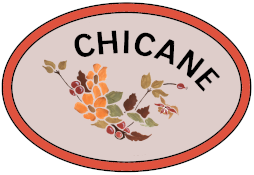
EDITORIAL
Christmas and the festive events, enjoyed by all, are now over and we are well into the new year, but as this is the first issue of 2019, I wish all readers and their families, a happy, healthy and peaceful year ahead.
As always, winter and its dark and dreary days has brought the inevitable seasonal coughs, colds and other ailments. For those who could wish for better health just now, we send our warmest wishes and hope you will be feeling better very soon. We also send good wishes to all newcomers to the Village and to all those who have moved away. We hope you will be happy in your new homes.
Although the mornings still seem dark, the evenings are drawing out; the bulbs are popping up and there are snowdrops out - spring is on its way. British Summer Time begins on the 31st March, don't forget to put your clocks forward an hour on Mothering Sunday [1.00 a.m.] or you may miss church services!
Although technically a freebie, the Newsletter costs approximately £1.50 a copy, so your donations are still welcome, appreciated and necessary! Some postal subscriptions have now run out and if you are someone to whom this applies, a letter is enclosed with your Newsletter.
This issue has lots of interesting articles thanks to the regular contributors and everyone else who has put pen to paper or e-mailed me articles; of course, Paul, our Artist in Residence and Sue and Mike Richards for the frosty and misty view of Watermouth from Napps on the cover. Items and articles for the next issue, covering April, Easter and May, would be appreciated as soon as possible and by Wednesday, 6th March at the latest. Thank you.
Enjoy your Newsletter and the events planned for you in the coming weeks.
Judie - Ed
1
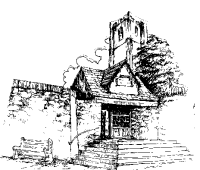
FROM REV. BILL . . .
Time seems to fly by. Take Christmas, the season of giving is
over, and then New Year which is well under way with all its resolutions [are
you still keeping them?], even Epiphany has passed by, hopefully not unnoticed!
And now we are beginning to look
forward to Easter as the Church begins Lent and of course Easter eggs are
already in the shops! All these times
can help us to look forward, to something, but do they? What
possible help can these different events bring? Are we kind of stuck like hamsters in a
wheel, going over the same ground as last year? If we are, perhaps it's something to do with
us not fully understanding.
For example, Christmas is about a
special baby's birth; a baby who brought NEW beginnings for the whole world. New Year brings the hope that things will get
better, Epiphany opens our eyes to NEW possibilities, and Easter to NEW life.
If we want to see people who are really
stuck, just for a moment step into the shoes of the thousands of people of
Yemen, California, Indonesia, the homeless, the destitute and many other
situations that people find themselves locked into. What
might they be looking forward to? What
might they be hoping for? There is a
sense that nothing changes because we could have asked the exact same question
12 months ago? All of us are hoping that these terrible world events may change
people's attitudes, that somehow the world will become a peaceful and safer
place. I hope that is true, but the reality is different: governments and terrorists continue to kill
people.
It was a revelation to the three kings
when they came and saw God's gift to the world, the baby Jesus, because they
saw wrapped up in rags the One who would bring real hope to a shattered world. Meanwhile the rich and powerful Herod was
trying to kill him. Eventually Jesus
would die for a shattered world, and rise again to bring new life and certain
hope. And he continues to do that today
for those who invite him into their hearts.
Bill
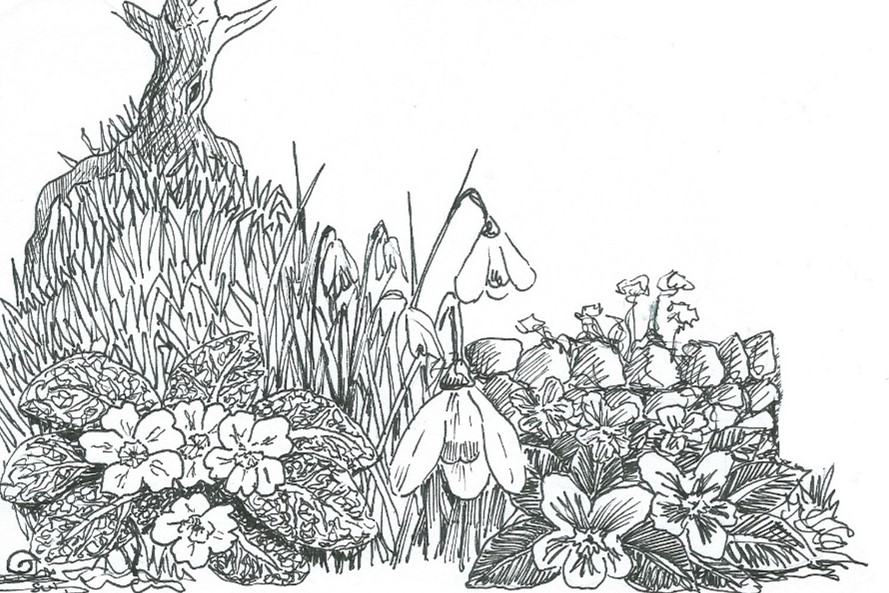
Illustration by: Paul Swailes
2

I hope you all enjoyed your Christmas
and New Year, as usual we did not see a white Christmas, in fact the day time
temperature on the 25th reached 11.6°C.
Looking first at November, we had a total rain
fall of 107.8mm which was below average and the driest since 2011 with 64mm. Maximum wind speed was 44 mph from the SSW on
the 29th courtesy of storm Diana. I should also like to mention on that day we
had a very short cloud burst which produced a rain rate of 84.8 mm an hour. I have never seen such rain before and it
was just as well it only lasted a few minutes!
The barometer only recorded seven
days when high pressure was in charge of our weather, highest was 1026.7mbars on
the 2nd and the lowest on the 7th at 984.7mbars. Temperatures ranged from 0.1°C on the 21st
and a maximum of 15.2°C on the 4th. The
coolest wind chill was -1.0° on the 26th.
The sun managed to shine for
24.83 hours, the lowest since 2015.
December continued with a low rain fall of
121.6mm. The wettest day was on the 7th
with 16.4mm. The highest wind speed was
40 mph on the 15th from the SSW. The
barometric pressure was up and down throughout the month with a high of
1036.9mbars on the31st and a low of 995.2mbars on the 15th, this time by courtesy
of storm Deidre. Temperatures were above average with a maximum of 13.2°C on
the 1st and a low of -0.4°C on the 14th. The lowest wind chill was 0°C on the 14th. The sun was in very short supply with only
2.94 hours, the lowest since figures started in 2002.
Continuing
my article about the weather records, I have copied and attach the 2018 annual
summary for outside temperature, precipitation and wind speed.
All my information is collected every
hour on the hour for the whole year. I
also have records for the following: inside temperature, humidity inside and out,
Dew point, wind chill, barometric pressure, rain rate and in air density. There is also the heat and cool comparison
based on my datum temperature of 18.3°C. I can print out full text sheets as well as
graph charts for most of the above information. My sunshine hours come courtesy of Chicane
although these are not that accurate at this time of the year due to the sun
being below the surrounding hills during part of the day.
2018 was the driest year on my records
beating 2017 by 22.4 mm. January had the highest wind speed at 48mph the
highest gust which I have recorded was in 2002 reaching 66 mph.
I
hope the previous and this article have answered some of your questions about
my weather interests. I wish you all a good year and enjoy
yourselves whatever the weather manages to send along.

3
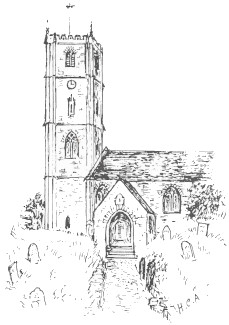
ST. PETER'S CHURCH
The post for a Priest in Charge
has been re-advertised and a new candidate was interviewed on Thursday 3rd of January for the position to serve St. Peter's
Berrynarbor, St. Peter's Combe Martin together with Pip & Jim's, Ilfracombe. We
are currently waiting to hear if the candidate was successful and will notify
everyone in the April edition of the Newsletter as to the outcome.
Our Christmas Carol Service on Wednesday
19th December was, as usual, very well attended, and how well the young children sang at
the earlier Service and also at the later Service commencing at 6.30 p.m. Both School and Berrynarbor Choirs sang
special songs and carols, and mulled wine and mince pies, plus other
refreshments for the children, rounded off the evening in fine style! We
thank Rev. Bill Cole for taking this special service.
Our Christmas Eve Service at 9.30 p.m. welcomed
many parishioners from both Berrynarbor and Combe Martin, together with
visitors - some of whom had travelled long journeys to attend this special
service which was conducted by Rev. George Billington. There was also a good attendance for the
short Family Service on Christmas Day, and many thanks to Graham Lucas who deputised for me on this occasion.
How nice it was to see so many attend from Pip and Jim's Ilfracombe, and St. Peter's Combe
Martin at our Joint Service held here in Berrynarbor at the end of December,
with Revs. Bill and George taking the service.
Once again, we are still hoping that
someone will come forward to fill the post of Organist at St. Peter's - if only
on a temporary basis. Music is an essential part of the Church
Service and if you know of someone who could help us out then we would be most
grateful. Please contact me, Stuart on 883893
for details.
Still on the subject of music, for
those who are interested in joining our Choir please contact Graham Lucas on
01271-883847 - or just come along to our Monday evening Choir practice in the
church at 7.30 p.m. and enjoy a sing-along!
Church
Services for February are as follows:
All Church Services commence at 11.00 a.m. and are as follows:
- 1st Sunday: Village Service
- 2nd Sunday: Holy Communion
- 3rd Sunday: Songs of Praise
- 4th Sunday: Holy Communion
N.B. There will be a Joint Service on Sunday, 31st
March at Pip and Jim's, Ilfracombe, commencing at 10.30 a.m.
In view of the PCC's desire to keep costs down covering water, electricity, gas, tower clock and organ servicing, building insurance [plus maintenance of internal and external parts of the Church, the Churchyard grass, Boundary trees and bushes], we have decided to go out to tender for all this necessary work to be carried out.
As a first step [but by no means the last] we will be going out to tender for the Churchyard Grass Cutting
Please contact our Secretary Alison Sharples [01271-882782] for a Tender Application Form.
The closing date for this work is 1st March 2019
Our AGM will be held on Tuesday 26th
March in the Church Vestry at 1.45 p.m. We
welcome all parishioners to attend this important meeting.
As many of you will know, Judie Weedon
became unwell in early January, and we send our prayers and good wishes for a
speedy recovery following her stay in hospital. We also pray for those who are unwell in
this Parish - especially Carol Lucas, Viv and Brian Fryer and also Pip Summers
who is recovering from a knee replacement.
Last,
but not least - The
Friendship Lunch will be held on the last Wednesday of the month in The Globe
Pub at 12.30
p.m.
Stuart
Neale
Thank you, Stuart for your good wishes, and my thanks to you all for your many cards, flowers and best wishes. I plan to be fighting fit again very soon!
Judie
4
BIG THANKS!
Firstly,
many thanks to Barry, Nic and the team at The Globe for providing a fantastic
Christmas Lunch in December for over 30, Jigsaw Project people - the food was
great, the venue fabulous, the atmosphere was just right to get everyone in a
festive mood - Ho! Ho! Ho! Also a huge thank you to Lynney
Bridle, Sandra Richards and Pat Martin - dressed as Santa's little elves - for
giving up their time to serve the meal, clear up and make the day very special
for everyone.
Secondly,
thanks and appreciation to everyone in Berrynarbor who donated wrapped
Christmas presents to give people who were unfortunately in a position whereby
they would have received very little.
The joy on people's faces, when the presents were delivered, showed the
true meaning of Christmas and for me, was a moment in time that is very
difficult to describe - their joyful tears will stay in my memory for a long
time. Thank you so much to you all for
making a difference.
Ann [Davies]
5

IN MEMORY OF JOHN GALE
July 1925 - October 2018
John Gale was the first Headmaster of
The Ilfracombe Academy or Ilfracombe School and Community College as it was
then. A pioneer in community education,
the founder of so many local institutions, a devoted husband, father and
grandfather, he leaves behind a great legacy.
John was born in the seaside town of Littlehampton on the Sussex coast. Whilst his origins were humble, his father a
railway worker and his mother a lady's maid, it was soon clear that he was an
extraordinary child. With an ambition and a drive that came to define who he
was as a man, he first gained entry to the local grammar school and then, at
the age of just 17, gained a place in Oxford University. He talked of arriving at Oxford in clothes
handed down by the aristocratic family his mother worked for and, not able to
afford college membership, was part of the Delegacy for Non-Collegiate Students
which later became St Catherine's College. These experiences had a profound effect, firing
his life-long commitment to creating equal opportunities in education. However, with the country at war, it was not
long before he abandoned his studies and joined the Royal Air Force where he
trained as a pilot, reaching the rank of Flight Lieutenant. Known for his amazing eyesight and powers of
observation, he was given the task of mapping and identifying enemy aircraft,
often flying in dangerous territories. It
was in 1942, stationed in Manchester and on his way to Canada for flight
training, that John met Pat, and so began their 70 years together. Pat's family owned a butcher's shop in
Manchester and she played her part in the war effort working in a munitions factory. They
wrote to one another for the best part of three years, letters John would keep
with him and treasure.
When the war ended, he went back to
Oxford to complete his studies, and he and Pat were married in May 1947. He tried out various jobs and went on to take
a 5-year commission in the Air Force as an education officer.
Now parents to twin girls, Elizabeth
and Patricia, they moved to Leicestershire where John worked in adult education
and they bought their first home using his end-of-service gratuity. His next move was a spectacular one when, at
the age of 31, he was appointed as Headmaster of Swavesey
Community College in Cambridgeshire, making him one
of the youngest headmasters in the country. Community education was an exciting new
initiative which combined comprehensive education with adult education, pre-school
and community work. Houses were built
around the college for staff, which was a centre for the community who were
encouraged to get involved. This suited
John perfectly.
Their third child John was born and the
three children enjoyed happy childhoods together playing around the campus. John had found a career he
truly loved, and he would look back on those seven years in Cambridgeshire
as very happy and fulfilling.
Then, in 1965, John was given his most
ambitious task to date. He was to move
to Ilfracombe to establish and ultimately open Ilfracombe Community College. This would see him first take on the role of Headmaster
of three other schools, before bringing them together to create a centre for a
community that stretched from Woolacombe to Lynton and Countisbury,
reaching out to all the villages, hamlets and towns in the area.
John's love of Exmoor began on these visits
and, spurred on by his enthusiasm for sharing Exmoor with the students of the College,
the school was bequeathed land on the edge of the moor. The Exmoor Centre was created. Built in the old grammar school hall, the Centre
was the creation of staff, parents and young people, and was carried out to
Exmoor on a fleet of tractors. To this
day it is a wonderful place and is remembered by so many who had the experience
of spending the first week of their time at the College at the Centre.
Ilfracombe Community College was
officially opened in 1972, the first purpose-built comprehensive in the
country. It was innovative and
ambitious, and John was hugely energetic, inspiring those who worked with him
to share his vision of community, of local people pulling together and to make
things happen.
John wanted to offer opportunities to
his students and one of them was travel. In 1972, Sixth Formers from the College
became the first British entrants to China after the end of the cultural
revolution, and a trip to India followed.
Despite the demands of running the College,
John managed to support the community through the Rotary Club. At this time, Pat began Country Cousins, a
business where students from overseas would come to stay in the town to learn
English.
With the children now out in the world,
John and Pat moved to Moorings, a beautiful home overlooking Watermouth castle
and the sea, buying up adjacent land to give Pat the garden she had always
dreamt of, but to visitors, more of a small forest or woodland. Whatever project John took on, he did to an
incredibly high standard, and the garden was no exception. Gardening, always an interest of John's,
became a passion.
Perhaps lured by the success the family
was having with Country Cousins, John retired from the College in 1982. A new era had begun. The business was
expanded, a building at Bicclescombe Park was bought, and later Patricia and
her husband John Swan took over the day-to-day running of the business,
focusing on achieving a standard of excellence in language teaching and the
hosting of students from overseas. This
focus eventually led to the prestigious award of British Council recognition,
and Pat and John travelled across Europe promoting Country Cousins.
A few years later they gave up work and
began to celebrate their retirement together, travelling the world, visiting
South Africa, Australia, New Zealand, China, Canada and the United states; times together they loved. Retirement was a time when John and Pat threw
their energy into numerous community groups and projects. Pat became a Samaritan and she and John
undertook the daunting task of raising £30,000 to provide a building for the
North Devon Samaritans. With friends
they established a branch of the University of the Third Age, U3A, a group for
retired people who strive to continue learning and sharing skills well into
their later years. John even led an annual residential trip to places of
historical interest. He was involved in
the Civic Society, becoming Chairman in 1988, an organisation
of over 100 local activists determined to encourage the development of the
town. His involvement in the Exmoor Centre
continued and he raised the funds for a full renovation. The Centre
later became a charity independent of Ilfracombe College and opened its doors
to children, families, young people and groups, who come from far and wide to
have the experience of living simply in the midst of Exmoor.
A Rotarian for 50 years, John served
the community tirelessly and was awarded the Paul Harris Fellowship for his
many years of dedicated service.
Another retirement project for John and
Pat was supporting their son who had gone to live in Tuscany. Together they bought and renovated a small
settlement of cottages in the hamlet of Castello. High up on the hillside,
surrounded by olive groves and with a simple farming population, this was a
place John and Pat truly loved. It was then that they experienced a tragedy of
the kind that no parent should ever have to experience. In
August 1990, their son John died suddenly.
His wife, Jenny, left heavily pregnant, gave birth to their first
grandson six weeks later. With amazing
courage and strength, Jenny was determined to bring their child up in Castello
and to finish the project and John and Pat spent countless weeks in Tuscany,
supporting her and doing all they could to help finish what their son had
started. The olive groves of Tuscany,
and the ancient twisted wood they had used to burn on the fires, inspired John
to start woodcarving. Many hours were
spent in rapt attention carving, sanding and chiseling, his work following the
patterns he found in the wood.
To their three grandsons, John and Pat
were known as Nonno and Nonna,
English pronunciations of the Italian words for Grandad and Grandma, and many
happy summers were spent at Watermouth with them, enjoying John's swimming pool
and charging around the garden, following all the winding paths John had
created.
When Pat was diagnosed with Alzheimers in 2002, John took on the advice of her
psychiatrist who suggested that activity, stimulation and travel would be
helpful. His unwavering devotion to her
in her final years was befitting of their 70 years together and, when Pat's
condition deteriorated,
John took on the role of full time carer. She died peacefully at home with John, in May
2012. Their separation after a lifetime
together was something from which John did not recover well. However, life at Moorings was far from empty
for John. Always interested in his
grandsons and their activities, he was a great source of encouragement and
inspiration for them, passionately concerned in everything they were doing.
His final years in Moorings were helped
by a team of loyal and lovely people. Maxine
Putman, his gardener for 16 years and a talented horticulturist, worked with
John and ensured that his garden flourished long after he was no longer able to
tend to it himself. Sue Potter, his and
Pat's carer for 12 years, supported by Alison, was a
great friend, allowing him to maintain dignity during this time. It meant so much to him to be able to live out
his final years there, and this would not have been possible without their help
and without the ongoing loving support of his family.
Words cannot describe the deep respect
and admiration so many have, and will always have, for John - the grandfather,
the father, the husband, the headmaster and the friend - truly one of
Ilfracombe's greats.

From the Editor:
I was fortunate to work with John as his personal assistant for seven years at Ilfracombe College - seven very happy but busy and eventful years. After his retirement we kept in touch and I was glad to be able to enjoy with him, his 93rd birthday in July. I shall miss him but thanks to the family, I am lucky enough to have one of his olive wood carvings in memory of a very special boss.
6

7
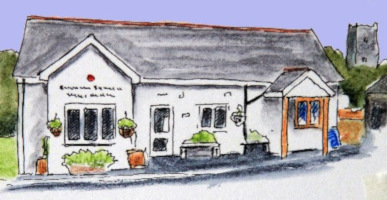
FROM THE VILLAGE SHOP & POST OFFICE
Don't forget Valentine's Day!

It
is commonly thought it is better to give than to receive, so don't disappoint
the special one[s] in your life by failing to remember that it is St.
Valentine's Day on Thursday, 14th February.
Our
village shop has a good and varied supply of Valentine cards and a special
selection of gift packs to mark the special day.
In
case you do forget. you may want to make the excuse that St. Valentine [beheaded
14th February AD269] in his day had nothing whatsoever to do with romance until
Chaucer came on the scene over 1000 years later. If that doesn't go down too well, we're
delighted to say that the shop always has the ingredients you will need to cook
that special romantic dinner -available all year round! - to show that you do
care. We have an excellent selection of wines too,
to help wash it down.
Christmas Hamper
Winners
The
first prize in the shop's Christmas raffle - a wonderful cheese and wine hamper
- was won by John Hood. The second
ticket out also belonged to John but being the generous sort that he is, he
declined another prize.
Tee
and Lloyd of Bowden's Farm were grateful to him as they won the Curry Kit
prize. Margaret and Roger Sowerby won
the bubbly and chocolates.
Great Berrynarbor
Plant Sale
A
date for your diary! Yes, we know it's
still a long way off but you will need to get planting soon if you are going to
be ready in time for the Great Berrynarbor Plant Sale, which this year is
taking place on Sunday, 19th
May in the Manor Hall.
This
is the weekend before the late May Bank Holiday. The Plant Sale is being held a week earlier
than in previous years so that it doesn't clash with other high-profile local
events.
8

NEWS FROM THE PRIMARY SCHOOL
Happy New Year to everyone!
We hope you all had a great
festive season.
Our Senior Dudes' Meal was a huge success! The
children thoroughly enjoyed preparing and serving to their grandparents and the
community. The hall and tables were decorated beautifully
and added to the ambience, and the singing at the end really finished off such
a lovely evening. Thank you to all who came along to such a
wonderful community event.
The Walking Nativity was a great success and thoroughly
enjoyed by all, with the addition of a donkey!
We finished the evening by
warming up in The Globe with mulled wine and tea/coffee. Guitarists, ukuleleists,
a saxophonist and pianists performed Jingle Bells, Rudolph the Red Nosed
Reindeer and Merry Christmas Everyone. We
closed the evening with the choir singing Mistletoe and Wine and Merry
Christmas Everybody. We should like to
thank The Globe for allowing us to use their family room and providing warming
refreshments!
We should also like to say another big thank you to The
Globe for donating the takings from their Christmas Raffle, £250, towards our
playground renovations.
Thank you to everyone that supported our Tesco Bags of
Help. We are just waiting to hear the
outcome and will keep you posted. The children have come back to school
refreshed and ready for the new Spring Term.
As a Federation we have increased our involvement with
musical events. During the Autumn Term children performed at
Exeter Cathedral and they took part in an all-day workshop with Debbie Kent [the
founder of the Teachers Rock Youth Choir] and Bazil
Mead [the Founder of the London Gospel Choir].
270 children and 100 adults from schools across Devon performed to an
audience of 700 people. The tickets sold
out in less than three weeks. This was
an amazing opportunity for the children.
We
also have several events coming up this term:
- Beaford
Arts Community Event - Performing, Tiny Heroes and
my choirs from both Schools will come together to perform on the 8th February
in the Manor Hall.
- Spring
Music Concert - every musician at Berrynarbor will play
their instrument, ranging from guitar, ukulele, saxophone and piano. The school choir will also perform some songs
and then there will be a grand finale with everyone singing and playing
together. [Date and place to be confirmed.]
- Exeter
Cathedral Choristers outreach programme -
singing with 40 children, from Years 4 to year 6, from each School and a grand
performance, 2nd March at Exeter Cathedral, with one song being sung by 80
children all together from the Federation. And they will also sing three songs with
children from other schools who are taking part in the outreach programme.
- Teachers
Rock Youth Choir, Spring and Summer Project with Debbie Kent
- five rehearsals in each term, in a local school and then the final
performance at The Grand Hall, University of Exeter on the 7th July with an audience
of 1500!
We are looking for volunteers to help in the school with
gardening and reading. We are also short of lunchtime supervisors [this
is a paid role]. If you have any spare time and would like to
help, please call the office on 883493.
Later this year we'll be holding an Aspirations event for
our oldest children. We are hoping to find people to come and talk
to the children about the many exciting things that they might like to do in
later life. If you or someone you know
have experiences that you would like to share with the children, please get in
touch and help us to inspire the next generation.
Thank you to everyone for your continued support of the
school.
Sue
Carey - Head Teacher
9

10

BERRYNARBOR WINE CIRCLE
'Whenever
a man is tired, wine is a great restorer of strength.'
Homer,
The Iliad
Majestic made a welcome return in November and Greg Cleverdon, a new face for us, but not to wine, gave us an
excellent presentation. His wine
selection was a timely-planned invitation to show us some of their wine stock
and to tempt us for Christmas purchases.
It worked!
They were all good. We started with the oldest white: an As Caixas Godello,
2015 from Galicia, north-west Spain. Many seemed to favour
the Godello grape, which has gained increasing
recognition as a quality varietal in its own right. If you wanted it as an alternative to a
usually-preferred Sauvignon Blanc, this could be the one. We, and others, made the journey to Old
Station Road and bought some! It may
have been the cheapest, but it seemed it tickled many taste buds!
 This was followed by one of their Definition
range: a Gruner Veltliner 2017 from Austria, a Silver Medal winner. The final white was a Spanish Mas Querido Field Blend 2017. Field blends are gathering in
popularity. The owner of the vineyard
for this product bought a derelict vineyard.
It was overgrown and he didn't know what grape, or grapes they were. He cut it back, dramatically, and mixed
it. Every year his wine is different. In tasting order, prices for these were
£8.99, £10.99 and £7.99; however, they are £1 or £2 per bottle
cheaper if you buy six.
This was followed by one of their Definition
range: a Gruner Veltliner 2017 from Austria, a Silver Medal winner. The final white was a Spanish Mas Querido Field Blend 2017. Field blends are gathering in
popularity. The owner of the vineyard
for this product bought a derelict vineyard.
It was overgrown and he didn't know what grape, or grapes they were. He cut it back, dramatically, and mixed
it. Every year his wine is different. In tasting order, prices for these were
£8.99, £10.99 and £7.99; however, they are £1 or £2 per bottle
cheaper if you buy six.
Sicilian sun and dried grapes contributed to our first red
and the Nero Oro Appassimento 2016 was an enjoyable
beginning. It was followed by another member of their
Definition' range. On a personal note, I
enjoy a Spanish Rioja, and this Reserva 2010 was
good, but the best was yet to come!
Malbec has, over time, become a personal favourite, but I appreciate
that it can be too strong or punchy for some.
The Vina alba Malbec-Touriga
National Reserve 2015, from Mendoza, Argentina, made for an interesting blend,
suitable with a large array of dishes - rich or spicy casseroles. The addition of the Touriga
National added complexity; it was full of flavour
and I'd drink it again and again: delicious!
Funnily enough, this too fell into our Majestic trolley before
Christmas! Reds' prices were £9.99,
£13.99 and £12.99, again in tasting order, with a £1, £2 or £3 reduction for
six.
Pedro Ximenez Triana
is Christmas Pudding - in a bottle! Greg
produced an unexpected pre-Christmas treat for us as he passed around tasters
of this very dark, rich and opulently sweet sherry as the finale to our very
enjoyable evening. The Bodegas Hidalgo
was founded in 1792 and ages the Pedro Ximenez grapes
in oak casks for several years. PX is a superb dessert wine but poured over
vanilla ice-cream - delicioso! Don't bother to cook, just present ice-cream
and PX! It's £16.99 or £14.99 when you buy seis!
Comyn Farm is still a working farm,
buried in the Chambercombe area of Ilfracombe.
It's an easy short hop from Berrynarbor and great for couples or
parties. To celebrate our 30th anniversary, and still
going strong, forty-five of us clambered on local buses and were chauffeured the
few miles for the occasion. We took our
own wines, which was useful, and enjoyed proper farmhouse cooking, and, I
suspect, the event was a great restorer in many ways! The photo depicts the chatting before the
eating!
Judith Adam
- Promotional Co-ordinator & Secretary
Please note that the
March meeting of the Wine Circle will be one week earlier, on the 13th March,
in the Function Room at The Globe.
11

NEWS FROM BERRYNARBOR PRE-SCHOOL
A first taste in Learning
We should like to welcome all our
families back to Pre-school and wish you all a Happy New Year. We hope you had an enjoyable Christmas break
and are ready to start the new term. We
should like to welcome all our new families and their children and hope they
enjoy their learning journey with us.
We should also like to welcome Sophie, a new member of staff
to our team.
Our
topic of learning
This term we shall be focusing on Maths:
counting, recognising
numbers and learning about the names and properties of shapes. Our activities will be based around the
story of The Elves and the Shoe Maker. We shall create a shop in our role play area
to support counting and number recognition.
Other Maths concepts such as measuring, weights, positional
language and shape names will be introduced. We'll also sing counting songs and rhymes.
If anyone has any shoe boxes they no longer need, we would
appreciate them for our Shoe Shop and role play.
School
Visits
We have been invited to Berrynarbor Primary School for regular short visits this term. This is an opportunity for the children,
especially those who are due to start school next September, to visit the
school and meet the teachers while still under our care and supervision.
We should like to say a big Thank You for your support at
our Coffee, Cakes and Carols Morning. The
Pre-school children sang so well and remembered most of the actions to the
songs. We received some lovely feedback
from parents, grandparents and from members of the community. A thank you also goes to the Primary School
children who gave us a taste of their Christmas Show. We raised a total of £269.00 which is
brilliant and will go towards equipment and resources for the children's
learning.
From the
staff at Berrynarbor Pre-school
Sue,
Karen and Lynne
13
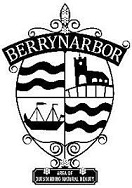
BERRY IN
BLOOM & BEST KEPT VILLAGE
Berry in Bloom is quiet at the moment although
up to the beginning of the new year the weather has been so mild that the
spring flowers in the tubs are' blooming lovely' and the bulbs are well up. Our team is having a well earned rest.
We
give our appreciation to our Parish council for the Christmas tree and
decorations in the centre of the village and their valiant attempts to keep the
tree upright in the windy weather before Christmas.
Each
newsletter, the heading to this article is Berry in Bloom and Best Kept Village
although there is no longer a Best Kept Village competition. This competition was previously run by the C.P.R.E
[Campaign for Protection Rural England].
I believe Berrynarbor started entering this competition in 1985 and its
organiser was Joy Morrow who lived at Fuchsia Cottage. After winning several times, Berrynarbor was
put in to the Previous Winners group but still managed to win in this group as
well. As the criteria for the Briton
in Bloom competition was almost the same, the village started entering that
competition too. Also, with great
success, culminating with Berrynarbor being asked in 2011 to represent the
South West in the National Competition where we won GOLD but came 2nd overall. Not bad
when that is against villages our size throughout Great Britain!
So,
this year 2019, we
shall again be entering Britain in Bloom and trying to keep up the good work around
the village. If anyone new wants to join us, we should
love to meet you. We will be having our
annual meeting inThe Globe at 7.30 p.m. on Tuesday,
19th March.
Wendy Applegate
14

Red Cross Cake
After
all the richness and indulgence of the Christmas and New Year period, this is a
recipe for a simple but delicious cake devised by Red Cross volunteers and
handed out to soldiers on the front line in WW1 to line their stomachs and keep
up their spirits.
Put the
following ingredients into a saucepan:
- 1 cup of brown sugar
- 1oz water and 2 oz seeded raisins [normal raisins are fine]
- 3oz lard or margarine
- One quarter of a nutmeg grated
- 1 tsp of grated cinnamon
- 1 oz grated ginger
- pinch of salt
Boil
together for 3 minutes and when cool, add 1 tsp bicarbonate of soda, dissolved
in a little water. Add 2 cups plain flour in which half a tsp of baking powder
has been sifted. Stir well.
Put
the mixture in a greased tin - no mention what size but I used an 8 inch
round loose bottomed one. Bake for one
and a quarter hours at 350-375F or 180-190C. Check after 1 hour.
There you have it. A century on Red Cross cake still lifts the
spirits! Thank you, Fenella, for
bringing this recipe to my attention.
Wendy Applegate
Suggested
from an original recipe:
Try soaking the
raisins in rum for a few days or a week before you make the cake! It also came with the recommendation that
the cake keeps fresh for a long time and can be sent to men at the front.
Wendy's
recipe brought to mind a memento from the Second World War sent in by Tony
Beauclerk. It is a letter of Thank You
sent by King George VI to members of the Home Guard [Gerald Vaughan Beauclerk].
Originally
called the LDV [Local Defence Volunteers] members initially just had arm
bands. All ages joined, some very
young, and later they had uniforms and eventually became part of the Devon
Regiment.

Berrynarbor's Home Guard outside the Manor Hall.

This photograph appeared in the December 2011 Newsletter and can be viewed here.
Gerald
Beauclerk 3rd from right, 3rd row back.
15
LOCAL WALK - 172
'The Echoing Green' - William Blake
I was glad when a neighbour suggested a
trip to Selworthy as I'd never been there. I'd seen pictures of course, of the idyllic
village, on calendars and in guide books but in real life it proved to be more
picturesque.
Thatched cottages with round chimneys
and latticed windows are arranged informally around a little sloping green
beside a brook.

They were built in the early nineteenth
century for Sir Thomas Acland's retired estate workers. He did not employ an architect but used a
pattern book, Rural Architecture published in 1823.
Selworthy
Green was designed to be an interesting feature in the landscape and to enhance
this notion the residents were issued with scarlet cloaks! So it was even a
visitor attraction two centuries ago.
Today one of the cottages provides a
welcoming cafe and another is a craft shop.
Noting the fifteenth century tythe barn
in passing, we reached the church. I
had often seen it from miles away and been curious about its white appearance
which makes it stand out. Apparently it is periodically coated with a lime mixture to
protect the stone from the weather.
All Saints' church has a sixteenth
century pulpit with sounding board to help project the preacher's voice; a much admired
wagon roof with angels and bosses; a Georgian
West Gallery supporting the organ and above the porch an unusual Squire's Pew
in the form of a Gothic pavilion which once included a fireplace.

Illustrations by: Paul Swailes
From Selworthy
Green a maze of paths plunges into the extensive woodland. To celebrate the birth of each of his
children, Sir Thomas Acland had planted a block of trees - larch, beech, birch
and oak.
We sat on a bench to enjoy the autumn
colour and the view overlooking Dunkery Beacon and below, Allerford
and Holnicote House and then a succession of jays
flew past. To see one jay is always a
pleasure, but six . . . !
In the eighteenth century, the Acland's Holnicote Estate was so large that it was said they could
cross from the Bristol Channel to the English Channel without leaving their own
property.
In 1944 Sir Richard Acland gave the
estate to the National Trust. He wrote,
"Would it not be rather wonderful to get away from 'this is mine', 'this is
yours', 'this is the other fellows' and look out on everything we saw and say
'this is all ours'.
Sue H
16
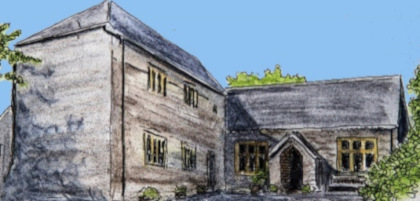
FROM THE MANOR HALL
TRUST
CIO 11619090
Well done to those who braved the
hideously wet and windy weather on our Christmas Coffee Morning and enjoyed a
drink and a mince pie,
We still managed to raise over £100 towards our funds, so a big
thank you to all who came along. Joseph
apologises for not making it but he was tucked up in
his warm dry stable after a busy night walking the village the evening before
with the school!
Thank you to the Berry in Bloom group
for generously donating £154 from their Carols in the Square evening, another
lovely village community occasion.
Our next big fundraiser is our Race Night
on Saturday 23rd February. There will be a hot supper [included in the ticket]
and a bar. Tickets are available from
the Village Shop. Please join us for
this fun evening.
Regular users of the Hall will be aware of the now serious problem we have with the floor. Unfortunately, we have no choice but to close the Hall from Monday 11th March for a period of 4 weeks to enable the repairs and to decorate afterwards. A big thank you to Nick and Barry at The Globe who have kindly said where possible user groups can use their back room free of charge. The Pre-school room and Men's Institute will not be affected.
Julia
- Chairman: Julia Fairchild [882783]
- Secretary:
- Bookings: Alison Sharples [882782]
- Treasurer: Alan Hamilton
- Health & Safety: Mandy Sykes & Martin Johns
17
IMPORTANT NOTICE - TENDER APPLICATION FORM
Churchyard Grass Cutting and Associated Maintenance
As mentioned in the contribution from St. Peter's Church, Berrynarbor PCC have decided to go out to tender for various works to be carried out on St. Peter's Church, including Churchyard Grass Cutting and Associated Maintenance.
If you would be interested in helping by carrying out this work, please apply for a Tender Application Form from our PCC Secretary,
Alison Sharples [Tel: 882782] The Tender closing date for Churchyard Grass Cutting and Associated Maintenance is Friday, 1st March, 2019.
18

19

PUBLIC
CONSULTATION
THE PARISH COUNCIL REQUIRES YOUR
INPUT!
Berrynarbor Parish Council is considering an outline
proposal offered by the North Devon Council [NDC] to take on the Freehold of
the Public Toilets and a 25-Year Lease of the Car Park located by the Village
Shop. In short, if the Parish Council
accepts the NDC's proposal, they will be able to ensure the continuity of the
provision of these services/assets to the village. However, it will come at financial cost to
individual Berrynarbor parishioners by way of an increased Council Tax
bill. If the Parish Council does not
accept the NDC proposal, the village may lose the use of these assets.
The Berrynarbor Public Toilets and Village Shop Car Park are
currently North Devon Council assets.
The NDC currently manages and maintains the car park, the Parish Council
maintains the public toilets via a grant it receives each year from the
NDC. These assets are considered "non-statutory
services" by the NDC, as such the NDC's financial obligations for supporting
these assets are coming under continued pressure in an effort to redirect NDC
funds towards other "statutory services".
The concern the Parish Council faces is primarily one around
securing the continued provision of the toilets and car park for the benefit of
the village. There is a precedence set
by the NDC to close, sell or outsource these types of assets, where public
toilets in other local parishes have been closed and some car parks sold to
property developers or outsourced to commercial parking companies to manage,
which has resulted in increased tariffs and enforcement.
The Toilets and Car Park are obviously important village
assets, utilised frequently by the parishioners and
the visiting public, encouraging trade to the Village Shop, Cafe and Public
House, as well as providing useful parking spaces for visitors utilising the parish amenities, including the school,
church, manor hall, etc.
Within the NDC's lease offer to the Parish Council, the
Council would incur a financial obligation to maintain and manage the Car Park
during the period of the lease [25 Years].
With the transfer of Freehold relating to the toilets, the Parish
Council would incur the financial obligations of managing and maintaining the
toilets, without the benefit of the annual NDC grant.
The NDC is offering the Parish Council a one-off payment of
£12,000 [£7,500 for the toilets and £4,500 for the car park] by way of
financial contribution to the Council's future financial obligations that the
Parish Council would incur managing and maintaining the assets. This contribution falls short of meeting the
Parish Council's forecast costs related to maintaining and managing these
assets. Should the Parish Council
decide to move forwards with the Lease of the Car Park and Freehold of the
Toilets, it would be required to increase the precept. Further information and costings can be found
on the Parish Council's website at www.berrynarborparishcouncil.org.uk.
The Parish Council will be voting on whether to accept the
NDC's proposal at the Parish Council meeting in the Manor Hall on Tuesday, 12th
February 2019 commencing at 7.00 p.m.
The Parish Council would appreciate hearing feedback from
the Berrynarbor parishioners on whether they would like the Council to reject
or accept NDC's proposal.
Replacement
of Bus Shelter on the A399 - Update
We are pleased to report that the replacement bus shelter
for the A399 has been ordered and is due for delivery in April 2019. The Parish Council would like to thank the
County Councillor for facilitating the replacement and providing grant funding
towards the purchase.
Vicki
Woodhouse - Parish Clerk
Venue
for the March Parish Council meeting to be confirmed. Please see notice board.
Berrynarbor Parish Council
Chairman - Adam Stanbury [882252]
Gemma Bacon [883341]
gemmabacon@berrynarborparishcouncil.org.uk
Jenny Beer
jennybeer@berrynarborparishcouncil.org.uk
Julia Fairchild [882783]
juliefairchild@berrynarborparishcouncil.org.uk
Denny Reynolds
dennyreynolds@berrynarborparishcouncil.org.uk
Vice-Chairman - Sian Barten [882222]
sianbarten@berrynarborparishcouncil.org.uk
Adrian Coppin [882647]
adriancoppin@berrynarborparishcouncil.org.uk
David Kennedy [07791 781283]
davidkennedy@berrynarborparishcouncil.org.uk
Clare White [882959]
clarewhite@berrynarborparishcouncil.org.uk
Parish Clerk - Victoria Woodhouse - clerk@berrynarborparishcouncil.org.uk
County Councillor - Andrea Davis [883865]
District Councillors - Yvette Gubb [882364], John Lovering [john.lovering@northdevon.gov.uk]
Snow Warden - Clive Richards [883406]
20
CROSSWORD ANSWERS
ACROSS
1. Pretend, 7. Begun, 8. Screams, 9. Ground, 11. Scots, 13. Dark, 14. Examine, 15. Arms, 16. Rinse, 17. Recoil, 21. Albania, 22. Steer, 23. Bedsits.DOWN
2. Racecourse, 3. Theatres, 4. Name, 5. Bear, 6. Guru, 9. Genie, 10. Narcissist, 12. Panel, 13. Decimals, 18. Cute, 19. Ibex, 20. Glue.21

CHILDHOOD LITERATURE
The
Squirrel, the Hare and the Little Grey Rabbit was the first tale of these three
delightful furry friends and their adventures - the boastful hare, the vain and
scatty squirrel and everyone's friend, little grey rabbit. These and other characters - Moldy Warp, Fuzzypeg, Wise Owl, Water
Rat and more - are in some 39 books, charmingly illustrated by Margaret
Tempest, the imaginings of Alison Uttley. For many of us born in the 20th century,
these books became the bedtime stories of choice.
Born Alice Jane Taylor in December 1884
in Cromford, Derbyshire, Alison Uttley was educated
at the Lea School in Holloway and the Lady Manners School in Bakewell. It was here that she developed a love of
Science, leading to gaining a scholarship to Manchester University to read
Physics. In 1906, she became only the
second woman honours graduate of the University. She then trained as a teacher at Hughes Hall, Cambridge
before taking up a post in 1908 as a Physics teacher at Fulham Secondary School
for Girls in West London.
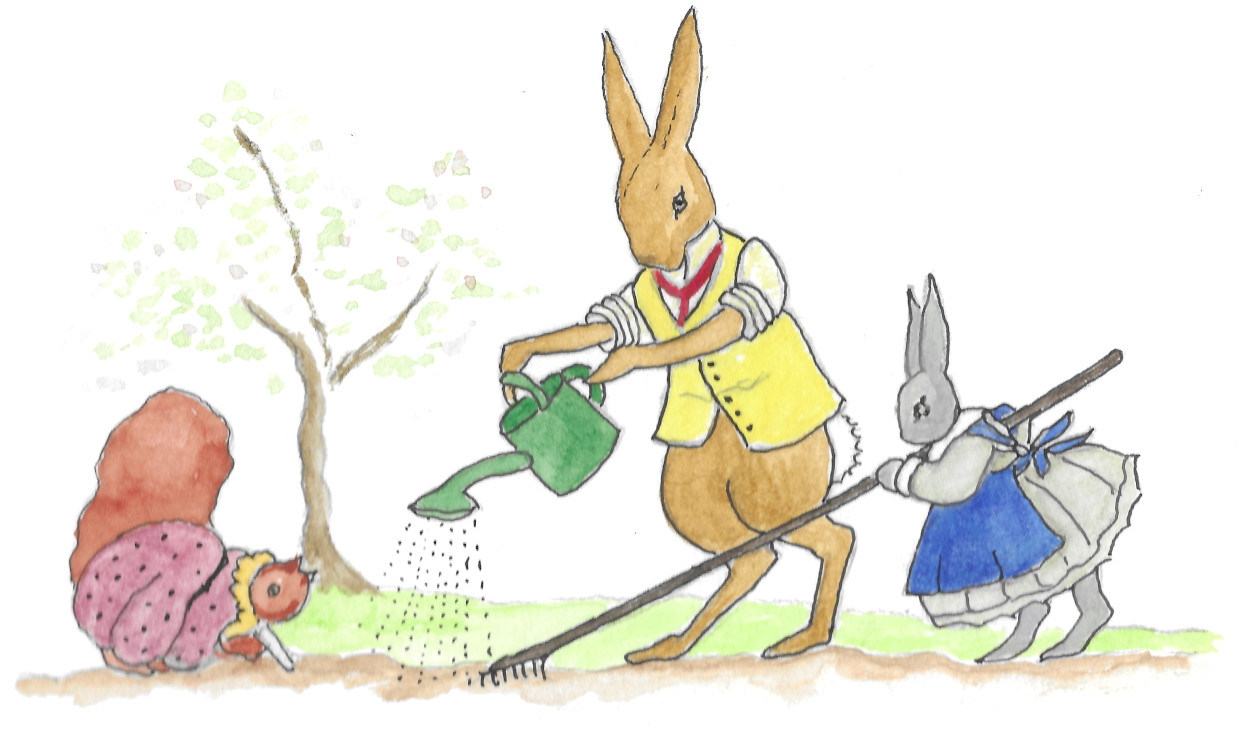
Little Grey Rabbit - after Margaret Tempest
Illustration by: Judie Weedon
In 1911 she married James Arthur Uttley and their only child on whom she doted, John Corin Taylor, was born in 1914. During the period 1924 to 1938, the family
lived in Bowdon, Cheshire, but sadly in 1930, and prone to depression, James
drowned himself in the River Mersey.
Some time
later, in 1938, Alison moved south to Beaconsfield where she became the
neighbour of Enid Blyton. Probably
jealous of Blyton's success, she came to dislike her, describing her as
boastful and vulgar. She also quarrelled
bitterly with her illustrator, Margaret Tempest.
The first Grey Rabbit, her first book
to be published, came out in 1929; other animal tales including the
Little Red Fox and Sam Pig followed.
Later, she wrote for older children and adults, focusing on rural
topics, notably in The Country Child [1931], a fictionalised account of her
childhood experiences on the family farm Castletop,
near Cromford.
In 1970 the University of Manchester
awarded her an honorary degree of Doctor of Letters in recognition of her
literary work.
She died at High Wycombe on the 7th
Mary 1976, aged 91.
From her diaries, published in 2009, it
is obvious that she was extraordinarily gifted but also very complicated. She was eventually estranged from Margaret
Tempest, over the copyright to her beautiful pictures and over which of them
had really created the characters. She
was bitterly resentful of comparisons with Beatrix Potter and scornfully
dismissive of Enid Blyton, whose work she despised. She took the work of literary creation very
seriously and relished her success, but was easily hurt by criticism and craved
affirmation from the public.
Extraordinarily gifted, she was also said to be singularly controlling
and dominating. Sadly, her son John,
whom she truly loved, killed himself two years after her death, by driving his
car off a cliff.
Margaret Tempest, author and
illustrator, was born in Ipswich, Suffolk, where she spent most of her
life. From 1914 she attended the
Westminster School of Art, co-founding
The Chelsea Illustrators Club, through which students exhibited and sold their
work.
In spite of not getting on personally
with Alison Uttley, from 1929 to 1960, she
illustrated the Little Grey Rabbit books, as well as other children's books,
including writing and illustrating her own, of the 'dressed animal' type.
Judie Weedon
22
MOVERS AND SHAKERS - NO. 79
MARY ANNING
[21 May 1799 - 9 March 1847]
Palaentologist
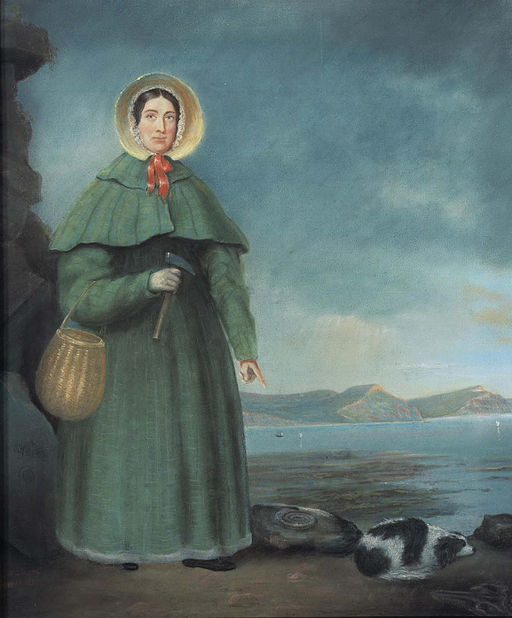
Posthumous painting of Anning by B. J. Donne from 1847,
based on the 1842 portrait, showing her pointing at an ammonite
B. J. Donne, Public domain, via Wikimedia Commons
Some
weeks ago, a heading in the Telegraph caught my eye, 'Winslet to portray fossil
pioneer's lesbian affair'. The film, Ammonite, will tell the story of Mary
Anning acting as nursemaid to a wealthy London woman who visited Lyme Regis for
convalescence and the relationship that presumably developed.
This is an amazing lady who became known
throughout the world as the greatest fossil hunter of all time, and one hopes
that the film will give her due credit!
Mary Anning was born in Lyme Regis in
1799 to a poor cabinet maker/carpenter, Richard Anning, and his wife Mary
[known as Molly] Moore. They had 10 children, but only Mary and her older
brother Joseph survived to adulthood - not unusual in the 19th century when
almost half the children born in Britain died before their 5th birthday.
At
the time of her birth, 'Mad' King George lll was on
the throne, small children of poor parents were sent off to work with little
schooling and girls weren't worth educating!
Mary's parents were Dissenters, that is not members of the
Church of England. Later, Dissenters
were known as Congregationalists and as such, they were not allowed into
universities, or the army, and were excluded legally from joining many
professions.
The Congregational doctrine, unlike the established church,
dwelt on the importance of educating the poor, and through Sunday School, Mary
was taught to read and write, but otherwise had a very limited education when
young.
The coast around Lyme was part of a rocky formation known as
the Blue Lias [layers of limestone and shale] and
rich in fossils. As a small child, she
and Joseph were taken by their father to look for these, which they brought
home, cleaned and polished, and sold as curios to visitors to earn a bit of
money. Sadly
her father died when Mary was just 11 years old, leaving the family destitute. They were forced to burn furniture to keep
warm and were in constant threat of the workhouse.
The next year, however, was a turning point. Joseph dug up a four-foot skull with large
sharp teeth. This was later named
ichthyosaur [meaning fish lizard]. A few months later, Mary dug up the rest of
the skeleton and sold it for a large sum in those days of about £23 to a local
estate owner who lived at Sandringham House in Norfolk. He then sold it to a well-known collector who
exhibited it in London where it created a lot of interest.
At this time, the general belief was that the world hadn't
changed since it was created in Genesis, so this fossilised
creature and others went against the grain with Mr. and Mrs. Average and Mary's
discoveries became very controversial. But
it made scientific folk look at different explanations for changes in the
natural world!
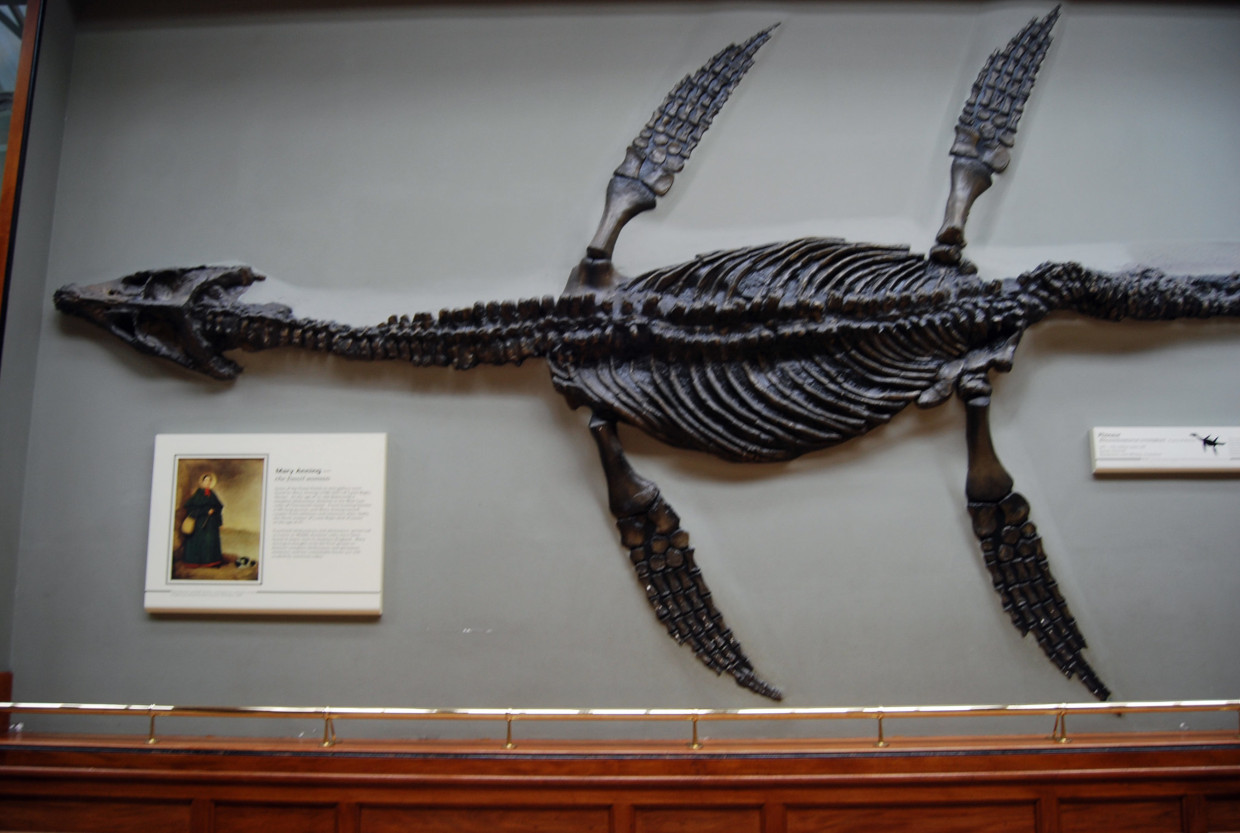
The first plesiosaur fossil found by Mary Anning in 1821 in Lyme Regis, Dorset
© Maggie Jones - Flickr,
Public Domain via PDM 1.0
Mary went on to make many other discoveries. I'm not a palaeontologist,
so shall have to watch carefully my spelling, but it's impressive to read that
she found the first complete long-necked Plesiosaurus [sea-dragon] at the age
of 23. This is still quite rare. Five
years later it was followed by a Pterodactylus
[flying dragon]. But as a woman and of
low social class, she wasn't allowed to join any major scientific institutions.
.jpg)
Simon Harriyott from Uckfield, England
CC BY 2.0, via Wikimedia Commons
The family set up a fossil-selling business in their home,
although Joseph didn't have much spare time, being apprenticed to an
upholsterer. Mary's mother ran it initially, but by 1825 Mary was running the
business.
In
the early days, they remained very poor, and after a year of finding no
significant fossils they were at the point of selling their furniture to pay
rent. One of their wealthy customers made
an act of kindness. He was Lieutenant
-Colonel Thomas James Birch who decided to auction fossils he'd bought from
them to raise funds, giving the family the credit for having found "almost all
the fine things which have been submitted to scientific investigation". The auction took place in London on May 15 1820
and raised £400 [about £26,000 in today's money]. It's
not known how much he passed on to the Annings, but
it made them more financially secure. They
started getting customers from Paris and Vienna and the auction made geologists
aware of them. Mary became known
throughout Europe and America as well as Britain, not only for her skills in
fossil hunting but also in anatomy. Yet
the only academic piece published during her lifetime appeared in the Magazine
of Natural History in 1839 in the form of a letter that she had written to the
editor, disputing one of its claims!
During her comparatively short life [she died of breast
cancer at the age of 47], Mary had two near escapes from death, the first when
she was only 15 months old. During a
thunderstorm she was being held by a neighbour
standing under an elm tree with two other ladies. Lightening struck
and killed all three women, but not Mary who was rushed home and revived in a bath of hot water. Her family declared that after this episode
she became much more curious and intelligent! On the second occasion, in 1833, she was
searching for fossils during the winter with her dog, Tray, when a landslide
fell just in front of them. The dog was
killed. Her comment afterwards was
"...the death of my old faithful dog has quite upset me, the cliff that fell
upon him and killed him in a moment before my eyes, and close to my feet...it
was but a moment between me and the same fate."
For someone with such a disadvantaged
early life, Mary gained much respect from both scientists and the public. Her death in 1847 was recorded by the
Geological Society, even though they didn't admit women until 1904. A stained-glass window was erected in her
honour in St
Michael's Parish Church in the town and in 2010, 163 years after her death, the
Royal Society included Mary Anning in a list of the ten British women who have
influenced the history of science. Had
it not been for her, Charles Darwin might have found his theories more
difficult to formulate! As an author
wrote in 1865 in 'All Year Round' edited by Charles Dickens "the carpenter's
daughter has won a name for herself, and has deserved to win it". The producer of Ammonite, think on!
It's not too far for a day trip to Lyme
Regis, particularly in summer. Its
museum is built on the site of Mary's house and has a separate section devoted
to her. She holds a special place in
the town. The Museum is even open in the winter from 10.00 a.m. - 4.00 p.m., Wednesday
- Sunday. Why not give it a go?
PP of DC
23

24
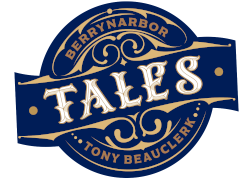
It was
night time and two burglars had just robbed a bungalow in the small village in
Essex. The Police had been called and
arrived just as they drove off.
The men
involved were Simon and Brian Brown who had also stolen the get-away car for
the occasion. But as soon as they set
off, the street lights went out.
"Put the
car lights on," said Simon.
"I
can't," replied Brian, "They won't work!"
"Turn left here," shouted Simon, "We'll have to get as far away as possible, until the hue and cry dies down."
So they took turning after turning.
"What did
you do with the bag we put the loot in?"
"I gave
it to you," Brian replied.
"I put
it by the boot of the car but forgot to pick it up," replied Simon.
It
seemed as though they would have been better staying at home!
Anyway.
it was pretty dark and they brought the car to a rest. At this moment the street lights came on
again.
Where
were they? Believe it or not they had
arrived right alongside the Police car.
"We've
been looking for you," said the Sergeant.
"Thank you for giving yourselves up."
"No
problem." said the lads in turn as they were handcuffed.

Illustrated by: Paul Swailes
Tony Beauclerk - Stowmarket
25
A HISTORY OF BERRYNARBOR SCHOOL - 1
I was
inspired to find out about the history of the village school partly by Judith
Adam's Book of Berrynarbor, based around the memories of Ron Toms, but also
because this was my school and I have very happy memories of my time there.
I have
always been fascinated by the past and - like many people - have researched my
own family history. Although I grew up in Berrynarbor and have
always considered it to be my home, my parents are from the Midlands and the
places of my ancestors are not ones I know.
I have always been drawn strongly by a sense of place and so came up
with the idea of researching the history of Berrynarbor School. This school was
central to my childhood, that of my sister, brother, niece and nephews; it is
also the heart of the village.
I am
gathering as much information as I can and then I intend to write a history of
the school. Sue Carey, Head Teacher of
Berrynarbor School, very kindly showed me three historic log books which are
held at the school. The first covers the
years 1874 - 1931; the
second 1931 - 1963 and the third 1963 - 1992.
At the moment I am transcribing the first book and have reached the year
1903.
Keeping
a log book was regulation for all grant-aided schools from 1862. The teacher was required to write in the book
at least once a week, noting details about pupil attendance, visitors to the
school, results of exams and information about what was taught. The book includes the names of teachers,
school visitors and pupils and these can be looked up using family history
online websites to produce short biographies.
The
first entry in the log book reads:
"January
16th 1874: The school was re-opened
under Government on Monday January 12th, but as the Registers did not arrive
from London until Wednesday the children could not be marked until Thursday
morning. The school was visited during the week by the Rector [The Revd. W Fursdon], his wife, who took the first class to a Reading
lesson; and Captain Williams of Watermouth Castle. Susan Harding appointed as a pupil teacher."

These
words were written by Rebecca Burgess, the Certificated Teacher at the school,
who appears to have been newly appointed at the beginning of the year; she remained at
the school until 1878. Unfortunately, because her name is quite common, it has
not been possible to find out any more about her, teachers often came from
outside the area so it is unlikely that she was local. Miss
Burgess was assisted by Susan Harding the pupil teacher. Pupil teachers were, as their name suggests,
teaching assistants drawn from the pupils at the school usually at 13 or 14 -
the age at which most children left school. Susan Harding was born in Berrynarbor in
1859, her father was a cordwainer [shoemaker] and she was the youngest of five
children. In 1861 her family was living
at number 29, the Village. She left the school in 1880 and
worked for a time as a shop assistant before marrying Willis Watts Furse and
settling in Ilfracombe. Furse was a Fruiter & Florist, a business
he shared with his brother-in-law Edwin Huxtable. In
1901 the two families were living together at No.1 the Promenade, Ilfracombe,
probably beside or above their shop. Susan
and Willis Furse had three children. They
appear to have done rather well for themselves because the 1901 Census shows
that five staff lived with them: a
governess, three domestic servants and a shop assistant. Susan
Furse died in 1905 at the age of 45.
From the log book it can be seen that
the children learned the elementary subjects [reading, writing and arithmetic],
did quite a lot of singing and that the girls did needlework. The school was divided into infants and the
main school. Children in the main
school were further divided into standards [I - VII], probably on the basis of
a combination of age and performance. There
are frequent comments about the children's attendance levels and the weather is
a big factor here, some children had to walk a distance to school and wet
weather in particular reduced their numbers. They were also kept back to help at home and
on farms, particularly with the potato planting in March. Throughout 1874 there were frequent visits
from the Rector, the Reverend Fursdon, also by Mrs Fursdon and their two daughters. Other regular visitors are Captain Williams,
Mrs Williams, their daughter and Squire Basset and his sister. The Bassets
lived at Watermouth Castle and owned most of the property in the village at
this time; Mrs
Williams was the married sister of the two Bassets. The Bassets and the Rector
were managers of the school and the teachers were accountable to them.
Notable
events at the school during 1874 include an evening concert in February to
raise money for a school bell. The bell
was erected in May. On Lady Day [25th March] several children leave school to
go into service. The school children were vaccinated in April;
this would have been
against smallpox, the earliest disease for which a vaccination was developed. In May the school had its annual inspection: there was praise for the sewing, singing and
discipline; reading and writing were fair, but arithmetic was very weak. The
school was threatened with a reduction in its grant if improvements were not
made. Three children are mentioned for
poor attendance: B Bere, MJ? Holmes and G Bere. Squire Basset
brought wood for the school fires in December.
Although
this part of the school story is too early for the memories of anyone living
today, I intend to continue into the mid-20th century. Lorna Bowden has very kindly shown me some
old photographs of school children, some of which had belonged to her aunt, Muriel
Richards. Miss Richards my first teacher; she had
attended the school as a child, gone on to be pupil teacher and then qualified
as a teacher.
If any
reader has old school photographs or memories which they would like to share I should
be very pleased to hear from you. Although
I no longer live in the village I visit often. My parents, Margaret and Keith Walls, live at Higher Rows Farm in the Sterridge
Valley. I can be contacted by email at tanyawalls@yahoo.co.uk or via Margaret and
Keith Walls.
Tanya Walls 26
COMMUNITY MINIBUS SERVICE
New Community Minibus Service to Barnstaple

The Community Minibus Service to Barnstaple Tesco and St. John's Garden Centre goes on alternate Fridays and started on Friday, 4th January.
It picks up in Ilfracombe at 9.30 a.m. in the High Street Garage, 9.45 a.m. at Berrynarbor, and Combe Martin at 10.00 a.m.
Other pick-ups by arrangement. There is a 2-hour stop in Barnstaple and the fare is £4.00 return.
If you would like to take advantage of this service, please phone Helen Roberts on [01271] 864882 to book with details of your pick-up place.
27

It seems to me there is a wide range of
opinion and sentiment about the period following Christmas and New Year. Some people literally experience post-Christmas
blues, their remedy a planned outing or social gathering in January in order to
prevent a come down from the adrenalin of non-stop celebrations. For others, the cessation of seemingly
endless socialising brings a sense of relief. Likewise, when I spoke to my nephew between
Christmas and New Year he, too, said he would be glad when it was all over, in
his case so he could get back to a normal work routine. Meanwhile, a work colleague justified her
negative outlook on the year's early months by stressing how the days can be
cold, the trees are still bare, there is no colour on show and the hours of
light remain short.

Although I cannot deny any of these
facts, I did feel the need to clarify my colleague's use of the word 'remain'
in relation to her last point. Yes, at
this time of year the hours of daylight are indeed outstripped by the hours of
darkness. But the length of each does
not remain the same from one day to the next. Indeed, as I compose this article, the clock
on the mantelpiece has just struck half past four and I am still able to write
this article in natural daylight. [Yes,
I still do my first draft by hand; I feel it allows me to truly express my
thoughts.] Yet it is only nine days
since the winter solstice; and by the time this newsletter is dispatched, the
sun will be setting roughly an hour later [either side of five o'clock,
depending on where you live] than it did on the 21st of December. Fair enough, we are still a long way off from
those long summer evenings - but at least we are heading in the right
direction.

What's more, for those of you who
experience symptoms of Seasonal Adjustment Disorder at whatever level, here are
some other little nuggets of comfort to help you during the months of late
winter and very early spring.
Whilst above ground all may seem
lifeless, beneath the earth out of sight and out of mind our soil is far from
asleep - and has in fact been active all winter even at temperatures well below
freezing. It is worth noting that a
considerable breakdown of plant material fertilizers and manure occurs
naturally over winter causing essential gases to be released. How
much is broken down then affects levels of phosphorous and carbon available for
spring growth. The level of gas released
is also dependent on the temperature of the soil, making insulation, courtesy
of ground cover, a key player in the process. This can be provided by grass, perennial
plant life, fallen leaves, a blanket of snow or frost.
Regarding the last of these, the
greenery you see around you in winter [it's there - you just need to look for
it] is no fool to frost for it is fully aware that soil can freeze up to
several feet below the surface in extreme conditions. To combat this grasses and plants send roots
deep under-ground - roots that throughout winter will natural discharge much needed
water into the soil. Alongside the
roots live many soil dwelling animals which have burrowed deep enough to avoid
the frost level. These include insects,
snakes, frogs, and worms. Some
hibernate whilst others live on food previously stored up in preparation for
the colder days ahead.
Such cold days can still be prevalent
as winter gives way to the embryo of spring. But in sheltered parts wild flora including
moss-loving sorrel, violets, primroses and colt's foot are free to flower. Blackthorn, too, makes its preliminary
appearance, a contrast to the dead auburn beech leaves that still cling to
their branches. It really is a case of
studying your rural surroundings for the work of very early spring is indeed
minute. There is a swelling of buds and
a sprouting of seedlings as the fabric of every leaf case is revealed. Notice
too how the trees take on a subtle inflorescence: a red haze over the elms; a thickening of the patterns sketched
upon the branches of the silver birches; a swagger of yellow male catkins upon the
hazel; a ruby glow over the larches; a
russet shine upon the alder's catkins; the
ash preparing bunches of purple flower buds within their black cases. All timid beginnings. Yet heralding so much
more to come.
Stephen
McCarthy
Illustrations by: Paul Swailes
28

KNIT & NATTER FOR THE NORTH DEVON HOSPICE
Once
again, the Craft Group will be holding a Knit and Natter afternoon to raise
funds for the North Devon Hospice.
We shall
be holding Open House in the Manor Hall during the afternoon of Monday, 25th
February. from 1.45 p.m. onwards.
Knitters can knit strips which the Hospice turn into blankets and for
this you will need an odd ball of wool and size 8 needles. But those who would like to just natter or
do some other craft are very welcome.
All we ask is that you give a minimum donation of £5.00 to the Hospice,
take part in the raffle, enjoy coffee or tea and cake and the company of others
wishing to support this very worthwhile cause.
We look
forward to seeing YOU there!
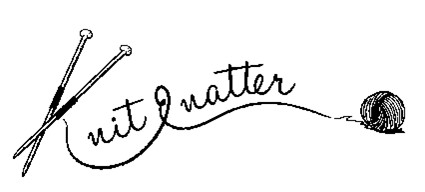

A
reminder that the Craft Group meets every Monday afternoon in the Manor Hall
from 1.45 p.m. Everyone is
welcome. Just come along and bring
whatever craft you are currently working on - needlework, knitting, embroidery,
beading, painting, etc. - chat amongst friends and enjoy tea or coffee and
biscuits - and all for just £2 a session!
The Art
section of the Craft Group meets on the 1st and 3rd Tuesdays in the month,
again at the Manor Hall and from 9.30 a.m.
On the 3rd Tuesday, Christine Grafton comes to support the group, either
with a technique lesson or to help with individual work.
New
artists, beginners and those with little or lots of experience are most
welcome. Why not come along to find out
more?
29

NEWS FROM YE OLDE GLOBE INN
Winter Opening Hours
Lunch Evening- Monday Closed 5.30 - 11.00 p.m. No food service
- Tuesday Closed 5.30 - 11.00 p.m. No food service
- Wednesday 12.00 - 2.00 p.m. 5.30 - 11.00 p.m.
- Thursday 12.00 - 2.00 p.m. 5.30 - 11.00 p.m.
- Friday 12.00 - 2.00 p.m. 5.30 p.m. - midnight
- Saturday 12.00 - 2.00 p.m. 5.30 p.m. - midnight
- Sunday 12.00 - 2.00 p.m. 6.00 - 11.00 p.m.
Don't forget!
- Valentine's Night - 14th February
- Mothering Sunday - 31st March
- Book early to avoid disappointment.
30
AT-A-GLANCE DIARY
| FEBRUARY | |
| 2nd | Soup and Pud Evening, Manor Hall |
|---|---|
| 8th | Beaford Arts, Tiny Heroes, Manor Hall |
| 12th | Parish Council Meeting, Manor Hall, 7.00 p.m. |
| 18th | to 22nd: Ilfracombe Academy & Primary School - Half Term |
| 19th | Wine Circle, Manor Hall, 8.00 p.m. |
| 20th | Talk on North Devon Biosphere, The Globe, 7.30 p.m. |
| 23rd | Race Night, Manor Hall, 7.00 for 7.30 p.m. 1st Race |
| 25th | Knit and Natter for ND. Hospice, Manor Hall from 1.45 p.m. |
| 26th | Mobile Library in Village from 11.40 a.m. |
| 27th | Friendship Lunch, The Globe, 12.30 p.m. |
| MARCH | |
| 11th | Manor Hall closed for repairs. |
| 12th | Parish Council Meeting, 7.00 p.m. Venue to be confirmed. |
| 13th | Wine Circle, Function Room at The Globe, 8.00 p.m. |
| 19th | Berry in Bloom: Annual Meeting, 7.30 p.m. The Globe |
| 24th | Marwood Hill Gardens open daily from 10.00 a.m. to 4.30 p.m. |
| 26th | Mobile Library in Village from 11.40 a.m. St. Peter's Church: AGM, 1.45 p.m. Church Vestry - all welcome |
| 27th | Friendship Lunch, The Globe, 12.30 p.m. |
| 31st | British Summer Time begins at 1.00 a.m. Joint Church Service, Pip & Jim's Ilfracombe, 10.30 a.m. |
| Manor Hall Diary | |
| Mondays | Upholstery, 9.00 to 1.00 p.m.Craft Group, 1.45 p.m. Badminton, 7.30 p.m. |
|---|---|
| Tuesdays | N.D. Spinners [2nd & 4th] 1st and 3rd: Craft Art Group, 9.30 a.m. |
| Wednesdays | Pilates Body Workout, 9.00 a.m. Primary School p.m. |
| Thursdays | Watercolour Painting 10.00 a.m. [10 week
terms] Pilates, 7.00 to 8.00 p.m. |
| Fridays | Toddlers Soft Play and Activity a.m. Primary School p.m. |
| Penn Curzon Room | Pre-School: Daily - Term time only Morning Session: 8.30/9.00 - 12.00 p.m. Afternoon Session: 12.00 to 3.00/3.30/4.00 p.m. All Day: 8.30/9.00 a.m. to 3.00/3.30/4.00 p.m. |
| Mobile Library | |
| Village Shop: 11.40-12.10 p.m. Sterridge Valley: 12.25-12.55 p.m. | |
School, Pre-School and Toddler Group - Term Time only
31

OLD BERRYNARBOR - VIEW NO. 177
Cockhill, Berrynarbor.96.

This rare view of [Middle] Cockhill
is yet another view taken by William Garratt of Bristol, around 1920, despite
the card having a 1928 postmark. Until
recently and for many years, Cockhill was the home of
the late Laurie and Peggy Harvey of King's Carpets, Barnstaple.
This
Small Holding was sold as Lot 19 in the Watermouth Estate Auction held on 17th
August 1920 at Bridge Hall, Barnstaple, as:
"Middle Cockhill, a very Desirable SMALL HOLDING, Comprising: A good Slated Dwelling House, convenient Outbuildings,
and about 13a. 2r. l;18p. Of Meadow, Pasture, Arable and Garden Lands, in the
Occupation of Mr. J.
Huxtable as a Yearly Lady-day Tenant. The
Apportioned Title on this Lot is £3 9s 0d."
The Lot
realised £750 on the day, being purchased by the existing Lady-day Tenant Mr.
J. Huxtable.
Tom Bartlett
Tower Cottage, January 2019
e-mail: tomandinge40@gmail.com
32
